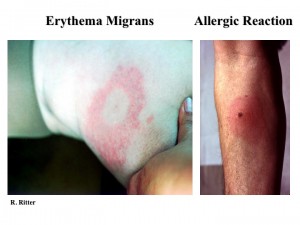Lyme comments, Mary Power (May 29, 2014)
These are my personal opinions from what I’ve learned and experienced with Lyme exposure at the Angelo Reserve. I do not claim to be any sort of authority on this subject. A colleague at Berkeley, Robert Lane, is a world expert in Lyme and other tick borne diseases, and he has generously contributed the slide presentation at this site. If you want to borrow slides from this for educational purposes, please request his permission at Blane@berkeley.edu.
Lyme on the California coast is conveyed by the western black-legged tick, Ixodes pacificus.

The nymphs (second from right) are the most dangerous—5-15% of these can be carrying Lyme bacteria, whereas only 1-4% of the adults (females on far right) are infected. The adult infection rate drops because if nymphs take a blood meal from Sceloporus lizards, common here, the bacteria in the tick is killed (talk about ecosystem services, thank you, Western and Sagebrush Fence Lizards!). The nymphs are questing (for blood) in spring and summer, and you’re more likely to be found by them if you sit in leaf litter or contact wood by leaning against a tree, or carrying fire wood, etc. After you’ve been in the forest, you should check yourself for attached ticks. I can generally feel them crawling. If you find one attached, grasp it as close to the head as you can with fingers or fingernails, and pull straight out. Don’t squeeze the body, or you can press the Lyme fluids in the tick into yourself. Also, dispose of the tick by burning it in a match, or flushing it down a toilet, but DON’T crush it with your fingernails, as I always used to do. Bob Lane told us that these Bourrelia spirochaetes that cause Lyme are one of the few bacteria that can drill through in tact human skin, so if you get dead tick juice on you, you could become infected.
I’ve been told that if you find a tick attached to you, but get it off (cleanly, without panicking, crushing it and squeezing its contents into your body) within 24-48 h, there’s no worry about it transmitting Lyme. I develop big itchy reactions to tick bites (like the right side of the picture below), but these are different than the

white-centered Erythema (on the left, and a more subtle, but definitive interior white ring on photo below) that are diagnostic of Lyme infection. I personally wouldn’t see a doctor if I got a tick off within 24 h, and got the reaction on the right of slide 5. I’ve had a lot of these. However, if I had a tick bite and didn’t get the Erythema, but did feel flu-like achy or low fever symptoms within the next few weeks, I definitely would see a doctor for a blood analysis. I think it might take 2-3 weeks for the bacteria to show up in your blood.

If you do test positive for Lyme, or see that definitive Erythema ring, you’ll need a prescription for Doxycycline (100 mg twice per day), and you’ll need to start taking it right away. Seriously, the same day you see the ring—get to the Fort Bragg walk in clinic or another clinic or medical office and don’t leave until you get that prescription, and fill it at the CVS down the street in Ft. Bragg (or any other pharmacy). Lyme becomes much more problematic as the bacteria get a chance to hide in places in your body where circulating antibiotics can’t reach them (nervous system, joints, muscles, see all the dire symptoms on Bob’s ppt, slide 4). A common medical prescription will be for a 10-day course of Doxycline—I’ve been told by experts that this may under-dose the infection, and I personally would insist on getting a 3-4 week course of the antibiotic. You do not want to present with late stage Lyme months or years later.